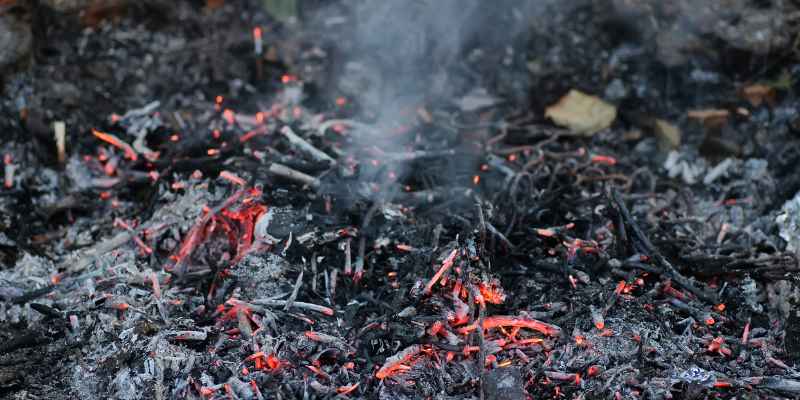Ash wood burning is a traditional method of wood combustion for heat or cooking purposes. It involves using ash wood as fuel.
In recent years, there has been a resurgence of interest in ash wood burning due to its eco-friendly nature and cost-effectiveness. Ash wood is known for producing a high heat output and long-lasting embers, making it an efficient choice for heating homes or cooking food.
Additionally, ash wood is readily available in many regions, making it a sustainable option for those looking to reduce their carbon footprint. When properly seasoned, ash wood burns cleanly with minimal smoke and ash residue, making it a popular choice for environmentally conscious individuals. Its versatility and affordability make ash wood burning a practical and environmentally friendly choice for many households.
Introduction To Ash Wood
Ash wood, derived from the genus Fraxinus, is known for its exceptional burning qualities. Its popularity in heating is attributable to its desirable characteristics, making it a sought-after choice for firewood. In this article, we’ll delve into the distinctive features of ash wood and its widespread use in heating applications.
Characteristics Of Ash Wood
Ash wood is renowned for its remarkable strength and flexibility, making it suitable for a myriad of applications. It boasts a pale brown hue with prominent grain patterns, adding to its visual appeal. The wood’s straight grain and smooth texture make it ideal for crafting furniture, tool handles, and sports equipment. Notably, ash wood’s high combustion efficiency and low moisture content contribute to its status as a favored choice for firewood.
Popularity In Heating
Due to its high energy content and low smoke emissions, ash wood is widely utilized as a fuel source for heating purposes. Its ability to generate consistent heat and long-lasting embers makes it an optimal option for wood-burning stoves and fireplaces. Additionally, the low ash residue produced during combustion simplifies the cleaning process, further enhancing its appeal for heating applications.
Benefits Of Burning Ash Wood
Burning firewood is a common way to heat homes during the winter months. While there are many types of wood available, ash wood is one of the best options to consider. Here are some of the benefits of burning ash wood:
High Heat Output
Ash wood is known for its high heat output. It produces more heat than other types of firewood such as pine or birch. This means that you can burn less ash wood to get the same amount of heat as other types of wood. Additionally, ash wood burns evenly and steadily, providing a consistent source of heat for your home.
Minimal Smoke Production
When you burn ash wood, you’ll notice that it produces very little smoke. This is because ash wood has a low moisture content, which means that it burns more efficiently. As a result, you’ll have fewer issues with soot buildup in your chimney and less pollution in the air outside your home.
Another benefit of minimal smoke production is that it helps to create a more pleasant indoor environment. There won’t be any unpleasant smells or irritants in the air, making it easier to breathe and reducing the risk of respiratory issues.
Overall, burning ash wood is a smart choice for anyone who wants to heat their home efficiently and effectively. With its high heat output and minimal smoke production, ash wood is a great option for anyone who wants to stay warm and comfortable during the winter months.
Comparing Ash To Other Woods
Ash wood burning is a popular choice due to its unique characteristics. Let’s compare Ash to other types of woods:
Heat Efficiency
- Ashwood generates high heat levels quickly.
- Compared to Oak, Ash produces similar heat output.
Burn Time
- Ashwood offers long-lasting burn times.
- In contrast, Birch burns faster than Ash.
Availability
| Wood Type | Availability |
|---|---|
| Ash | Readily available in most regions. |
| Maple | Slightly less available than Ash. |
Preparing Ash Wood For Burning

Seasoning Process
Ash wood needs to be properly seasoned before it’s ready for burning. This involves allowing the wood to dry out naturally, reducing its moisture content to an optimal level. Seasoning ash wood is crucial for efficient and clean burning, as well as to prevent excessive smoke and creosote buildup in the chimney.
Optimal Storage Methods
Proper storage is essential to maintain the quality of ash wood for burning. It should be stored in a well-ventilated area, protected from moisture and direct exposure to the elements. Optimal storage methods include stacking the wood off the ground on pallets or a rack to ensure proper airflow, and covering the top to shield it from rain or snow.
Best Practices For Efficient Burning
Burning ash wood efficiently in your stove requires proper stove settings and wood placement techniques. By following these best practices, you can maximize heat output, minimize emissions, and ensure an effective and eco-friendly burning experience.
Stove Settings
When it comes to stove settings for burning ash wood, it’s important to find the right balance between air intake and heat output. Follow these guidelines for optimal stove settings:
- Start by opening the air vents fully to establish a good flame.
- Gradually adjust the air vents to achieve a steady burn and maintain a consistent temperature.
- Avoid closing the air vents completely, as this can lead to smoldering and inefficient combustion.
- Regularly monitor and adjust the stove settings as needed to maintain a clean and efficient burn.
Wood Placement Techniques
The way you arrange the ash wood in your stove can greatly impact the burning efficiency. Follow these wood placement techniques for optimal results:
- Stack the wood loosely to allow proper airflow between the logs.
- Place smaller pieces of wood at the bottom of the stove to create a solid base for the fire.
- Add larger pieces on top of the smaller ones to ensure a consistent heat output.
- Leave enough space between the logs to allow for efficient combustion and prevent smothering of the fire.
- Regularly replenish the fire with additional wood to maintain a steady burn.
By implementing these stove settings and wood placement techniques, you can optimize the burning efficiency of ash wood in your stove. Remember to always follow the manufacturer’s guidelines for your specific stove model and consult a professional if you have any concerns or questions.
Safety Considerations
Ash wood burning can create a cozy atmosphere, but safety is paramount. Let’s explore some crucial safety considerations:
Fireplace Maintenance
Regularly clean and inspect your fireplace and chimney. Remove any ash buildup to prevent fire hazards.
Smoke Detectors And Fire Extinguishers
- Ensure smoke detectors are installed on every floor.
- Place fire extinguishers in easily accessible areas.
Environmental Impact
Burning ash wood can have a significant environmental impact, releasing harmful pollutants into the air. This contributes to air pollution, deforestation, and climate change, emphasizing the importance of sustainable wood-burning practices and alternative energy sources.
Ash wood burning is a popular method of heating homes and cooking food. However, it is important to consider the environmental impact of this practice. In this section, we will explore the sustainability of ash wood, emissions, and air quality.
Sustainability Of Ash Wood
Ash wood is a popular choice for burning because it is readily available and burns hot and slow. However, it is important to ensure that the wood is sourced sustainably. This means that the wood is harvested in a way that does not harm the environment or deplete natural resources. Sustainable ash wood harvesting practices include selecting only mature trees for cutting, leaving younger trees to grow and replenish the forest. By sourcing wood sustainably, we can ensure that we are not contributing to deforestation or other environmental problems.
Emissions And Air Quality
When burning ash wood, emissions are released into the atmosphere. These emissions can have negative impacts on air quality and contribute to climate change. It is important to ensure that ash wood is burned efficiently to minimize emissions. This can be done by using a modern, high-efficiency stove or fireplace and properly maintaining it. It is also important to burn only dry, seasoned wood to reduce emissions. Additionally, it is important to be aware of local air quality regulations and guidelines to ensure that you are not contributing to air pollution in your area.
In conclusion, ash wood burning can have both positive and negative environmental impacts. By ensuring that the wood is sourced sustainably and burned efficiently, we can minimize the negative impacts and enjoy the benefits of this renewable energy source.
Exploring Advanced Heating Technologies
As the world becomes more conscious about the environment, the demand for advanced heating technologies is on the rise. One such technology that has gained popularity in recent times is ash wood burning. This method of heating is not only cost-effective but also reduces the carbon footprint, making it a sustainable option for homeowners. In this blog post, we will explore the concept of ash wood burning and the advanced heating technologies associated with it.
Hybrid Heating Systems
Hybrid heating systems are the latest trend in the world of ash wood burning. These systems combine traditional wood-burning stoves with modern heating technology to create a more efficient and eco-friendly heating solution. The hybrid system uses a wood stove to heat the water that is then circulated through a boiler. The boiler, in turn, heats the home using radiant heat or forced air. This system is not only efficient but also reduces the amount of wood needed to heat the home.
Future Trends In Wood Burning
The future of wood-burning is looking bright, with advancements in technology and sustainability. One of the most promising trends is the development of high-efficiency wood-burning stoves. These stoves are designed to burn wood at a higher temperature, resulting in more complete combustion and less pollution. Another trend is the use of wood pellets as a fuel source. Wood pellets are made from compressed sawdust and are a renewable energy source that produces less ash and emissions than traditional firewood.
In Conclusion
Ash wood burning is an advanced heating technology that is both efficient and eco-friendly. With the rise of hybrid heating systems and future trends in wood burning, this method of heating is only going to become more popular in the coming years. As homeowners look for sustainable heating solutions, ash wood burning is sure to be at the forefront of their minds.

Frequently Asked Questions
Q: How Does Burning Ash Wood Compare To Other Types Of Wood?
A: Ash wood burns efficiently and produces high heat output. It is comparable to oak and maple in terms of heat generation and burn time.
Q: Is Ash Wood Suitable For Indoor Wood Burning?
A: Yes, ash wood is a great choice for indoor wood burning. It burns cleanly with minimal smoke and sparks, making it ideal for fireplaces and wood stoves.
Q: Can I Use Ash Wood For Cooking And Grilling?
A: Absolutely! Ash wood is safe to use for cooking and grilling. It imparts a mild, pleasant flavor to food and burns evenly, making it perfect for barbecue enthusiasts.
Q: Is Ash Wood Easy To Ignite?
A: Yes, ash wood is relatively easy to ignite. It has a low moisture content, which means it can be lit quickly with minimal effort. This makes it convenient for starting fires.
Conclusion
Ash wood burning is an eco-friendly and efficient way to heat your home. Its low moisture content and high energy output make it a popular choice for many homeowners. With proper storage and handling, ash wood can be a sustainable and cost-effective heating option for years to come.


